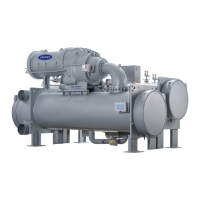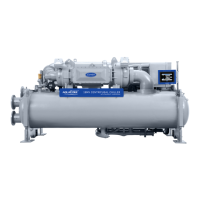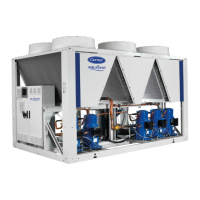34
MODIFY EQUIPMENT CONFIGURATION IF NECESSARY
The Configuration Menu has other tables to select, view, or
modify parameters. Carrier’s certified drawings have the con-
figuration values required for the jobsite. Modify these values
only if requested. Tables include Service Parameters, General
Configuration, Reset Configuration, and Protocol Configura-
tion. Modifications can include:
• Chilled water reset (CONFIGURATION MENU→ RESET
CONFIGURATION MENU)
• Entering chilled water control (Enable/Disable) (MAIN
MENU→SETPOINT)
• 4 to 20 mA demand limit (CONFIGURATION MENU→
GENERAL CONFIGURATION)
• Auto restart option (Enable/Disable) (CONFIGURATION
MENU →OPTION CONFIGURATION MENU)
• Remote contact option (Enable/Disable) — active when
chiller is in Remote mode
See the 19XR with PIC 6 Controls Operation and Trouble-
shooting guide for more details about these functions.
VFD CONTROL VERIFICATION (NON-RUNNING)
VFDs with ISM requires low voltage controls verification. The
PIC software monitors VFD Target Speed (VFD_Out; J8B-
1,2), VFD Speed Feedback (VFD_In; J6-1,2); it will declare
abnormal condition Alarm if the VFD Target Speed and Actual
VFD speed differs by greater than ±10%. The ISM outputs a 4-
20 mA target speed signal to the drive from terminal J8B-1.
The speed output and the actual drive frequency need to be cal-
ibrated to match along the speed curve. This low calibration is
done with the drive in “Low Voltage Test Mode” or without the
power leads connected to the motor so the chiller cannot start.
Go to MAINTENANCE MENU →ISM CALIBRATION →
J8B 4-20 MA OUTPUT. ENABLE calibration and set for
20 mA signal. Record and enter actual mA signal as received
by VFD or mA meter and execute. Then go to VFD status
screen and verify that the Target VFD speed is 100.0%. It will
now need to be confirmed that the target VFD speed is 100% at
the drive. Then the Actual VFD Speed is verified on the PIC
(this is the VFD Speed Feedback of 5 or 10 vdc (depending on
selection) vdc to input of the ISM is J6-1,2. If the Target and
Actual VFD Speed values are different when given a 100% tar-
get speed signal and after the signal at the VFD panel is con-
firmed to be 60 Hz (50 Hz), then the output voltage from the
drive can be calibrated to match the actual voltage being read
at ISM terminals J6-1,2 (MAINTENANCE MENU →ISM
CALIBRATION → J6 0-10V INPUT). The chiller must be
shut down to enable ISM Calibration.
Upon successful calibrating the drive and the ISM setting at the
100% target speed repeat at speed settings 90%, 80% and 70%.
See Table 12.
Procedure is complete when for all points the Target VFD %
matches the Actual VFD Speed % as obtained from the PIC5
VFD Status screen matches within 5% or better.
Perform a Controls Test (Quick Test/
Quick Calibration)
Check the safety controls status by performing an automated con-
trols test. Actuators with feedback like inlet guide vane actuator
need to be calibrated using the Quick Calibration menu prior to
unit startup. Other controls tests can be done using the Quick Test
Menu. The Quick Test or Quick Calibration menu can be accessed
from the MAIN MENU. (The QUICK TEST screen can only be
accessed when the chiller is in STOP mode.) On the QUICK
TEST table screen, select a test to be performed.
The Quick Test checks all outputs and inputs for function. In
order to successfully proceed with the controls test, the com-
pressor should be off, no alarms showing, and voltage should
be within ±10% of rating plate value. Each test asks the opera-
tor to confirm the operation is occurring and whether or not to
continue. If an error occurs, the operator can try to address the
problem as the test is being done or note the problem and pro-
ceed to the next test.
NOTE: If during the controls test the guide vanes do not open,
verify the low pressure alarm is not active. (An active low
pressure alarm causes the guide vanes to close.)
NOTE: The oil pump test will not energize the oil pump if
cooler pressure is below –5 psig (–35 kPa).
When the controls test is finished, the test stops and the
QUICK TEST menu displays. If a specific automated test pro-
cedure is not completed, access the particular control test to
test the function when ready. For information about calibration,
see the sections Checking Pressure Transducers, page 55, and
High Altitude Locations, page 55.
Quick Calibration, which is also located in the Main Menu, is
used to calibrate inlet guide vanes and devices with 4-20mA
feedback. Calibration is mandatory for chiller function and
controls will not allow the chiller to start if calibration is not
completed.
Check Optional Pumpout System Controls and
Compressor
Controls include an on/off switch, a 0.5-amp fuse, the compres-
sor overloads, an internal thermostat, a compressor contactor, re-
frigerant low pressure cut-out, and a refrigerant high pressure
cutout. The high pressure cutout is factory set to open at 185 psig
(1276 kPa) and reset at 140 psig (965 kPa). The low pressure
cutout is factory set to open at 7 psia (–15.7 in. HG) and close at
9 psia (–11.6 in. HG). Ensure the water-cooled condenser has
been connected. Ensure oil is visible in the compressor sight
glass. Add oil if necessary.
See the Pumpout and Refrigerant Transfer Procedures and Option-
al Pumpout System Maintenance sections, pages 39 and 50, for
details on the transfer of refrigerant, oil specifications, etc.
Charge Refrigerant into Chiller
The standard 19XR chiller is shipped with the refrigerant al-
ready charged in the vessels. However, the 19XR chiller may
be ordered with a nitrogen holding charge of 15 psig (103 kPa).
Evacuate the nitrogen from the entire chiller, and charge the
chiller from refrigerant cylinders.
Table 12 — Calibration Settings
SIGNAL J8B
(4-20 mA)
TARGET
SPEED (%)
FREQ
(50 Hz), Hz
FREQ
(60 Hz), Hz
20.0 100 50 60
18.4 90 45 54
16.8 80 40 48
15.2 70 35 42
CAUTION
The transfer, addition, or removal of refrigerant in spring
isolated chillers may place severe stress on and damage ex-
ternal piping if springs have not been blocked in both up
and down directions.
CAUTION
Always operate the condenser and chilled water pumps
during charging operations to prevent freeze-ups.

